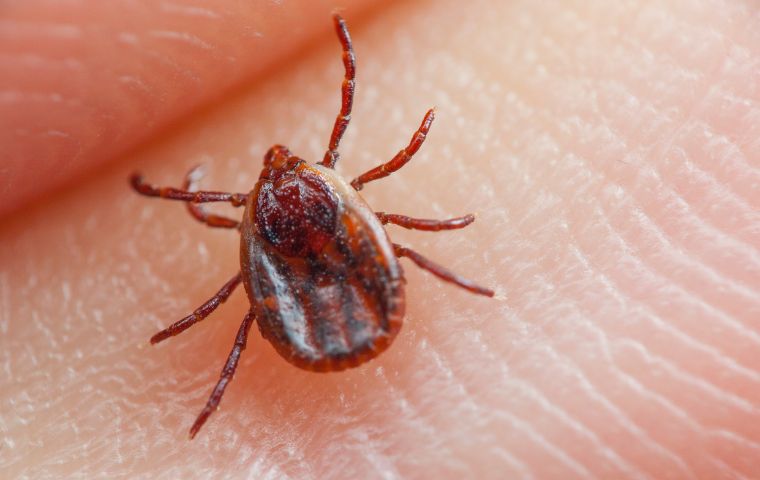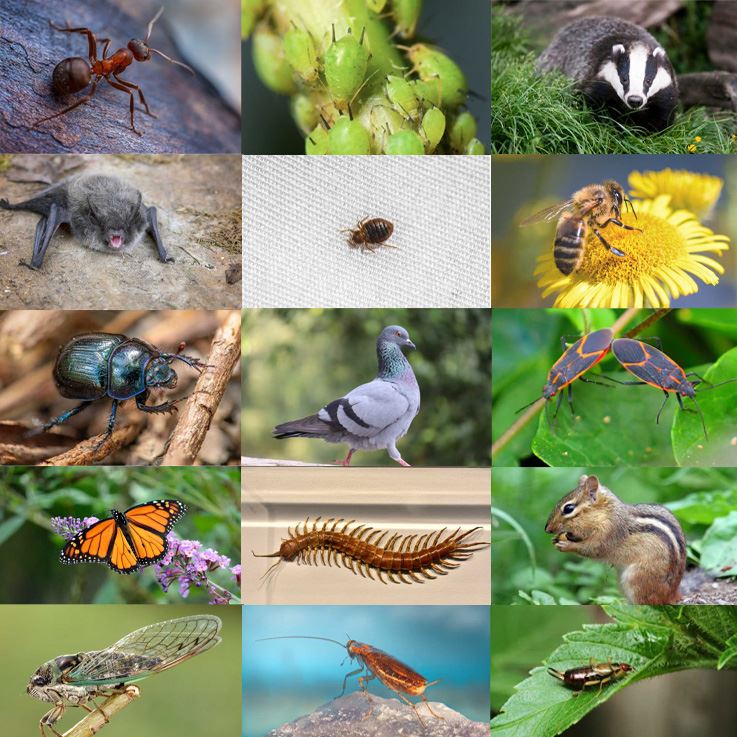
Brown Dog Ticks
What Are Brown Dog Ticks?
Brown dog ticks, scientifically known as Rhipicephalus sanguineus, are a type of tick species that primarily infests dogs. They are ectoparasites, which means they live externally on their host's body, feeding on their blood. Here's an overview of brown dog ticks:
Are Brown Dog Ticks Harmful?
Brown dog ticks (Rhipicephalus sanguineus) can be considered harmful in several significant ways, posing risks to both animals—especially dogs—and humans. While they are one of the few tick species that can complete their entire lifecycle indoors, making them a particularly troublesome pest, their threat extends well beyond simple nuisance. Here are some of the potential harms they cause:
Disease Transmission
Brown dog ticks are vectors of several serious diseases, particularly to dogs but also to humans under certain conditions:
- Canine Ehrlichiosis: Caused by Ehrlichia canis, this disease is one of the most significant threats associated with brown dog ticks. It can lead to fever, weight loss, anemia, bleeding disorders, and in chronic cases, death if untreated.
- Canine Babesiosis: Caused by Babesia canis vogeli and related species, this disease destroys red blood cells, leading to anemia, weakness, jaundice, and potentially organ failure.
- Rocky Mountain Spotted Fever (RMSF): Though more commonly associated with other tick species, brown dog ticks can transmit Rickettsia rickettsii to humans, particularly in the southwestern United States and Mexico. RMSF is a potentially fatal illness if not promptly treated.
Pet Health and Well-being
- Blood Loss and Anemia: Severe infestations can cause significant blood loss, especially in puppies, small breeds, or immunocompromised dogs.
- Skin Irritation and Secondary Infections: Repeated tick bites can cause intense irritation, allergic reactions, and skin infections.
- Stress and Discomfort: The constant biting and attachment cause distress to pets, potentially affecting their appetite, sleep, and behavior.
Human Health and Psychological Impact
- Bite Reactions: Although brown dog ticks prefer dogs, they will bite humans if dog hosts are unavailable. Bites may cause irritation, rashes, or in rare cases, transmission of disease.
- Fear and Anxiety: Home infestations can create psychological distress for homeowners, especially when the ticks are visibly crawling on walls, bedding, or pets.
- Health Risks to Children and Elderly: These groups may be more vulnerable to tick bites and potential disease transmission due to weaker or developing immune systems.
Brown Dog Tick Appearance
Brown dog ticks, scientifically known as Rhipicephalus sanguineus, exhibit distinct physical characteristics at various life stages. Here's a description of what brown dog ticks look like:
Adult Brown Dog Ticks:
- Size: Adult brown dog ticks are relatively small, typically ranging from 1/8 to 1/4 inch (3-6 mm) in length.
- Color: As the name suggests, they are often reddish-brown in color, but the exact shade can vary. They may appear somewhat mottled.
- Body Shape: These ticks have a flattened and elongated oval body shape when not engorged with blood.
- Scutum: Adult female brown dog ticks have a characteristic shield-like structure called a "scutum" on their backs, which gives them a unique appearance. This scutum is absent in males.
Engorged Brown Dog Ticks:
- After feeding on a host's blood, brown dog ticks become engorged and can appear larger, more rounded, and a darker brown or grayish color.
Nymphs and Larvae:
- Nymphs and larvae of brown dog ticks are smaller and have six legs, while adults have eight legs.
- They are also reddish-brown and flattened in shape but lack the scutum seen in adult females.
- As nymphs and larvae feed, they become engorged, similar to adult ticks.
Eggs:
- Brown dog tick eggs are tiny and oval-shaped, typically measuring less than 1 mm in length. They are laid in clusters, often attached to surfaces near the tick's habitat.
The appearance of brown dog ticks can vary based on factors such as the specific environmental conditions and the host they have been feeding on. Regular inspection of your dog and its environment for ticks is crucial for early detection and control, especially in regions where brown dog ticks are prevalent. If you find ticks on your dog, it's advisable to use appropriate tick removal techniques and consult with a veterinarian for further guidance on tick control and prevention.
Brown Dog Tick Habitat
Brown dog ticks (Rhipicephalus sanguineus) are primarily associated with environments where dogs are present, as these ticks have a strong preference for canine hosts. Here are the habitats where you might encounter brown dog ticks:
- Homes and Yards: Brown dog ticks are often found in and around homes where dogs reside. They can infest kennels, dog houses, and any areas where dogs spend time, including yards, gardens, and outdoor living spaces.
- Kennels and Dog Boarding Facilities: Places where dogs are kept in close proximity, such as kennels and boarding facilities, are common habitats for brown dog ticks. These ticks can easily transfer from one dog to another in such environments.
- Dog Parks and Pet Play Areas: Public dog parks and pet play areas may harbor brown dog ticks if dogs with tick infestations visit these places. These ticks can be present in grassy and shaded areas where dogs play.
- Residential Areas: In regions where brown dog ticks are prevalent, they can be found in residential neighborhoods, particularly in homes with dogs. Ticks may hide in and around outdoor structures and vegetation.
- Warmer and Drier Climates: Brown dog ticks thrive in warmer and drier climates. Therefore, regions with Mediterranean-like climates or tropical areas are more likely to have these ticks.
- Indoor Spaces: Brown dog ticks can infest indoor environments, particularly if a dog with ticks gains access to a home. Ticks can hide in cracks and crevices, as well as bedding or furniture.
- Shaded and Vegetated Areas: Ticks, including brown dog ticks, tend to prefer shaded and vegetated areas, as they can avoid desiccation (drying out). This includes areas with tall grass, shrubs, and bushes.
- Wildlife Habitats: While their primary hosts are dogs, brown dog ticks can occasionally attach to other animals, such as wild canids like foxes and jackals. Therefore, you might encounter them in areas where these animals are present.
To reduce the risk of encountering brown dog ticks and to prevent infestations, it's essential to implement tick control measures for your dogs, maintain a clean living environment, and conduct regular tick checks on your pets. Additionally, consider using preventive measures such as tick collars, topical treatments, and consultation with a veterinarian for guidance on tick control in your specific region.
Brown Dog Tick Diet
Brown dog ticks (Rhipicephalus sanguineus) are obligate blood-feeding ectoparasites, which means their primary source of nutrition is blood. Their choice of host is primarily canines, particularly dogs, and they feed exclusively on the blood of these animals. Here's an overview of what brown dog ticks eat and their feeding habits:
Brown Dog Tick Hosts:
Brown dog ticks prefer dogs as their primary hosts, and they are highly adapted to this specific host. They may also attach themselves to other domestic and wild canids, such as wolves, foxes, and jackals. In the absence of dogs or when the opportunity arises, they can occasionally attach to other mammals, including humans, but this is less common.
Brown Dog Tick Feeding Process:
- Attachment: When a brown dog tick finds a suitable host, it attaches itself to the host's skin using specialized mouthparts designed for piercing and blood-feeding.
- Feeding: The tick pierces the host's skin with its mouthparts, which include a barbed feeding tube and specialized structures for anchoring itself in place. It then sucks the host's blood through this feeding tube.
- Blood Meal: Brown dog ticks feed on their host's blood for several days, gradually engorging themselves as they ingest more blood. This engorgement causes the tick to swell and become larger and more rounded.
- Detachment: After completing their blood meal, brown dog ticks drop off their host and seek shelter for digestion, molting, or egg-laying, depending on their life stage.
During the feeding process, brown dog ticks can transmit various diseases to their hosts if they are carrying pathogens. Canine ehrlichiosis and canine babesiosis are two examples of diseases that can be transmitted by these ticks to dogs. To prevent tick infestations and reduce the risk of disease transmission, regular tick checks on dogs and the use of tick control measures are essential.

Brown Dog Tick Life Cycle
The life cycle of brown dog ticks (Rhipicephalus sanguineus) consists of four stages: egg, larva, nymph, and adult. It's important to note that the duration of each stage can vary based on environmental conditions, temperature, and the availability of hosts (primarily dogs). Here is the brown dog tick's life cycle:
- Egg Stage: The life cycle begins when a mated female brown dog tick feeds on a host (usually a dog) and then drops off to lay eggs. She may lay several thousand eggs at once. The eggs are typically laid in clusters, often in sheltered areas close to the host's resting place, such as in cracks, crevices, or dog bedding. The eggs are oval-shaped and very small, measuring less than 1 mm in length.
- Larva Stage: After a period of incubation, the eggs hatch into larvae. Larvae have six legs and are very small, often measuring less than 1 mm in size. They are generally reddish-brown and actively seek a host for a blood meal. Once they find a host, they attach, feed for several days, and then drop off.
- Nymph Stage: After feeding as larvae, they molt into nymphs. Nymphs have eight legs, similar to adult ticks, and are slightly larger and more developed than the larvae. They also seek a host for a blood meal, attach, feed, and then drop off.
- Adult Stage: Once fully engorged with blood, nymphs molt into adult brown dog ticks. Adult female brown dog ticks are typically reddish-brown and have a characteristic shield-like structure on their backs called a scutum. Adult males are smaller and lack the scutum. Both males and females seek hosts for blood meals, and after feeding, they may mate on the host. Mated females then drop off the host to lay eggs and complete the life cycle.
The entire life cycle of brown dog ticks can be completed in as little as two to three months under favorable conditions, but it can be longer in colder or less hospitable environments. The availability of suitable hosts, such as dogs, is a key factor influencing the duration of the life cycle. Effective control measures, including regular tick checks on dogs and environmental treatments, can help prevent infestations and manage these ticks at various life stages.

Hear From Our Happy Customers
-
"Professional & Considerate"
I’m pleased with Miche services. Jarvis came today. Professional and considerate. Thank you!
- Judy B. -
"Wonderful Service"
Wonderful service. Jarvis is great. Took care of everything I needed. Thank you!
- Henry P. -
"Exceeds Expectations"
I can’t say enough positive things about this company... The tech that came out, Jarvis went above and beyond my expectations. Thank you guys, I will continue using your services.
- Jake M. -
"Great Communication"
Tech was on time, communication was great, and he accommodated my needs.
- Alonzo W. -
"Fantastic & Patient"
Jarvis was fantastic and patient. He answered my questions with an in-depth explanation and addressed all of my areas of concern. Would love for him to be my assigned tech going forward. Well done!
- Yonnette M. -
"Very Knowledgeable"
The tech that arrived was courteous, professional, and very knowledgeable. He was Great.
- Uerial I.



